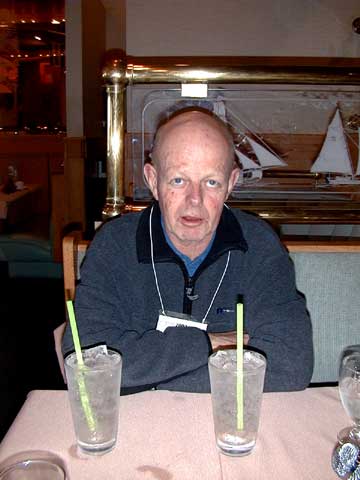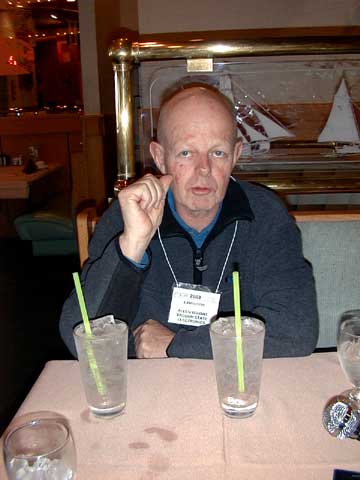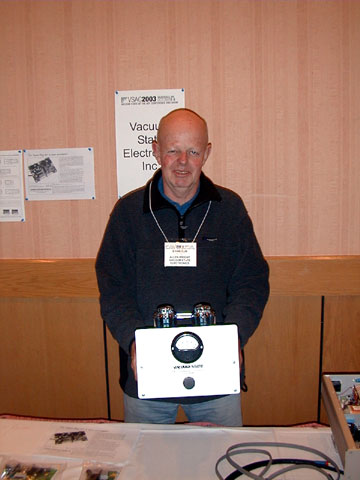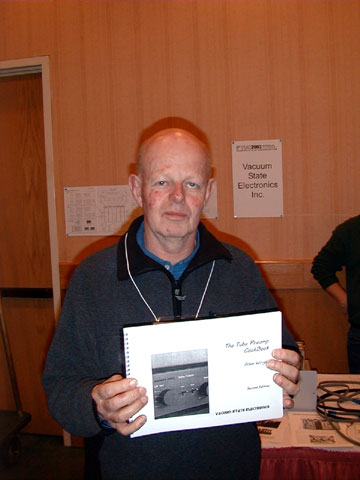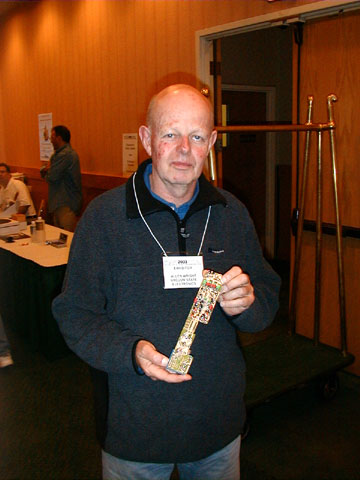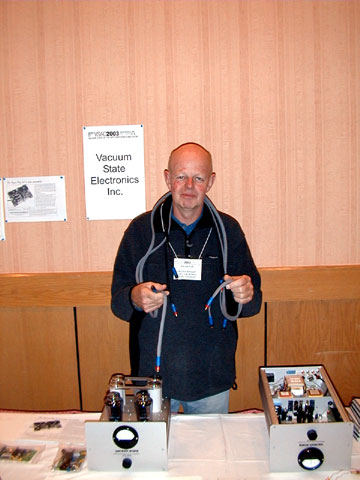|
You are reading the older HTML site Positive Feedback ISSUE 9 october/november 2003
Positive Feedback Online Interviews: Allen Wright of Vacuum State
Electronics
(Photographs and image processing by Robinson) On October 4, 2003, Allen Wright took some time out from VSAC 2003 to talk with Ye Olde Editor about his work in fine audio. An edited transcript of the conversation follows… Robinson: Allen, do you remember who it was who introduced us? Harvey Rosenberg! Harvey was the one who said, "You have to read this guy Allen Wright’s cookbooks. He has these great books!" I would like to know if you could spend some time telling our readers how you got into fine electronics and audio.
Wright: I love music. I think that is the bottom line. I built myself a record player at 14 or so from two old radios and a turntable. I didn’t really think too much more about audio as a profession. I grew up in New Zealand & went to University in Auckland. Then I moved up and built myself a high-fi system. It was the first solid state thing I did. I was interested in high tech at the time and I built that. I was working in the industry in electronics in measuring instruments and so on. I finally ended up with a job at Hewlett Packard, which taught me the real high precision aspect. Still, high-fi really wasn’t anywhere in my life. With music—sure, I had a sysytem and loved music and bought a lot of records. My previous job before HP had been with an company where this guy had built a very, very high tech AM radio tuner, and he was another technician in this place. We talked about it. In high school I had built ham radio stuff. I figured that I knew radio and radio receivers and that technology. He said that this was a tube tuner that he had made. He said you could not do it in solid state. This was a challenge! With the resources of the Hewlett Packard service center with all their test instruments, I built a solid state AM tuner that did manage to do better than his tube AM tuner. This was just a hobby or challenge. I did that in the evening and built the thing using HP's equipment like that. We finished it off and it looked OK and we took it around to a couple of shops and everybody was stunned and we got orders. Suddenly, we were in the high-fi manufacturing business. My then wife—ex-wife now—was taught how to solder, and she built them at home while looking after the babies. I would test them and calibrate them at night and sold them. This was our ongoing business. When the marriage broke up I just sort of changed my whole lifestyle. Before working at HP I worked at a high-fi shop which got me turned onto high-fi. This was just a regular store that was importing Luxman amplifiers from Japan but it was a big store for Australia. They sold a lot of tube amps, and I built up things for them, and so on. It got me fired up and interested. This high end tuner was going on and on as a business—and then I sold it. Some guy wanted to pay an insane amount of money for it as a business because he needed something as a startup so I thought "OK!" Then someone gave me a contract to design an amplifier which I designed and they manufactured it. This would be '73-74. It was fascinating to me. Robinson: So in the early '70s you made a transition into building amplifiers. Where did you go from there? Wright: I ended up setting up a shop which was a high-end service shop. We also had some stuff on demo and we sold a few things we built. In and around that time, I met a guy whose name was Rowan McComb who was an Englishman who lives in Australia. He is known in my books as "the guru." That is the absolute word for him. Some people have accused me of saying that I am "the guru," but this is not the truth. This guy is "the guru." I heard this guy’s high-fi system. I had been working in and around high-fi for about five years by then. When I heard his system at his place I could not believe it. It was just something else. It took ages to even realize what was happening, and it was just fantastic. It was just fantastic! He built stuff in wooden boxes and it was absolutely non-commercial. I saw the possibilities and I made a deal with him and said, "Can we put your designs into production ?" This is the guy that placed me over the edge, and he was well over the edge himself. He pushed me beautifully over the edge! He gave me some chicken tracks on paper which were the schematics and everything of his amps. I put them onto circuit boards, got them looking & working in a way that we could sell them, and then they became a production item, both pre-amps and power amps. This was never big-time, but it moved along; he got a bit of money out of it, and I got money out of it. Robinson: I have heard this before quite often in fine audio: a person is good at electronics or loves stereo, and things go along until they contact that "life-changing person." This is the person that really points them in a completely different direction, or teaches them that there is some much higher level.
Wright: Yes, this was like quantum jump. I had made a tiny jump, but this was like a mega jump—a whole paradigm shift. I put his stuff on the circuit boards and got it sold. It sold and it got some really nice reviews in Australia. I took a pre-amp to the US and sold it to a couple of people, and we even got a review on it in some magazine in San Francisco that has since closed. It was going on OK. Then I had the second paradigm shift. We had a major repair system going and we did a lot of guitar amps, anything tube. We would repair or upgrade any high end stuff. Customers would bring us well known pieces. Getting into them, I could see that a lot of high-end gear had too much doodah, tone controls and switches etc. I thought, "If we minimalized it, it would work a lot better." I called customers up and said their repair was finished—maybe $100.00 for repair—but we could build this thing into something really nice if they wanted it. They would say, "How much?" We would settle on a price and they would say, "Go for it!" But one time I had a very nice tube preamp in, the first really up to date tube preamp and got the go ahead to work on it. I took everything out except the bare necessities of the thing, and at about 6:00 at night when it was finished I put it in the shop system and went out to eat. I came back to the workshop to listen to it and compare it and while it was still fairly cold, the "Guru"designed solid state unit that I was comparing it with was better, but it still sounded nice. By about midnight, the modded tube unit and the solid state were even. By 2:00 in the morning, the modded unit was ahead. By 6:00 in the morning, it killed the solid state preamp. It just absolutely killed it! This was like, "I don't believe it!" Backwards and forwards I went with the comparison. Finally, I stick it under my arm, jump in the car and go around to the "guru’s" place, beat on his door. He comes down, I put it in his hands and I tell him he has to hear this thing, and I went off to bed. The next night I came around, beat on his door and no answer. The lights are on and he is inside, but he doesn’t answer. It took two weeks to get it back! To get it back, I waited untill someone else who lived in the house came to the door, and I ran in and I got it back. He didn’t apologise, just said that it was amazing. That was the tube revolution. We haven't built any solid state since. Robinson: It reminds me of a one-of-a-kind pre-amp that my good friend, Jennifer Crock built. It was the same thing. She took a chassis and did her own thing with it. I got to listen to it for just a weekend with a good friend of mine who works for a very large audio firm which builds beautiful gear. He had come over for the weekend, and we were doing some listening. He kept looking over at the pre-amp and saying, "What pre-amp is that?" By the end of the weekend he said, "That is a very good pre-amp." I don't think that we have nearly exhausted the possibilities of tubes. Wright: So, I started doing tube stuff. I attended a seminar once and one of the speakers said that "a professional is a person who is paid to practice." I was being paid to practice by doing modifications. You could take a Phase Linear 700 and put a current source in the input and suddenly this thing became good music, very powerful. It shifted it so much. I got to practice on a huge range of equipment. Sometimes it didn’t work, but most times the ideas did work, and I really got a feel for what works and what doesn’t from the standpoint of music. I got a lot of feedback from my clients. They would get it back and say that they didn’t like the bass or something, and you would work with it more until it was really fabulous. Around 1980, I hit a brick wall. I couldn’t make our preamp better. The preamps were sort of 12AX7-based Audio Research style. I couldn’t get it better than that in that style. Having worked at Hewlett Packard, I remember oscilloscope circuits that were flat from DC to 50 megahertz with no negative feedback, no noise and all this sort of stuff. I called up my old boss and said, "Can I come by and look at all of the service books?" I spent an afternoon at HP looking at their schematics. I went home and built basically what would be a vertical amplifier from a 50MHz tube HP scope. That became the differential preamp I have now, with many changes, but that same concept. It is effectively a Hewlett Packard vertical amplifier. Fully balanced differential and no negative feedback.
Allen Wright with his fully differential, fully balanced amplifier. Robinson: I have heard that from Jennifer a few times—the same concept. The idea of a fully true differential pre; fully—front to back. Of course, ultra high bandwidth. There were a lot of people for many years who said that all you needed was "20 to 20." My reaction, beginning many years ago, was that I think "20 to 20" is not enough. Wright: It depends on what comes after the "20"! Robinson: "20 kHz is insufficient." What we are trying to get right is something in that range, but human hearing is different than what we think it is. Even to get the upper end of that range right, we have to get multiple harmonics way up into the ultrasonic range. Wright: Well, I like two decades each side. 2 MHz at the top end, and 0.2 Hz on the bottom. DC to daylight. Robinson: You got established, and this was clearly your calling. How did Vacuum State Electronics form and get to Germany? Wright: Early 80’s in Australia we made a few bad business decisions, and the company went under. We re-formed in 1983 and called it " Vacuum State " because we were just doing tube stuff. In '91, I was in Switzerland and gave a talk at a seminar there for something completely different. The woman who was translating—well, we ended up getting together, and she seemed to be the woman for me. Half of it was the fact that she thought she could move to Australia if she married some guy from Australia, which actually isn’t the case. I ended up moving to Germany. She was at the University at the time doing a philosophy degree, and she had two years to run. It would have been two years before we could have been together, and I was actually bored with beautiful sunny days and living 15 meters from the ocean! So I moved to Germany where the beer is even better, but no ocean. But there was so much more possibility for audio business. Australia had no reputation and we were fighting to get people to recognize us. Robinson: It is hard to find a critical mass of population for audio in the boonies. You have to have a certain size of population to assure yourself of that small group that represents fine audio lovers. Wright: The overall financial climate in Australia was affecting everyone. They were looking for the best price, and no one was prepared to finance a top line product. "Can't we do that cheaper, make the metal thinner, use surplus tubes?" In Germany, it’s "How much is it? Can I try it in my home for a while?" "Sure." Then they put the cash on the table. Different attitude. Robinson: There really is a German passion for engineering, for precision and craftsmanship. It just seems to be part of the national character of the German people. As a Porsche lover, I know that! Wright: They do it right from the start. For me, I can get on my bike, ride downtown in 20 minutes, and I can go to a store that sells me every part that I use in these amplifiers except for a couple of bits that I bring in from the US. We are talking absolute quality components. People here at VSAC look inside my amp and are saying to me, "Where do you get this, and where do you get that?" I get it from my store downtown. They have it in stock. None of this "order it and wait." Robinson: You have got yourself established in Germany at this point. That is when Harvey pointed me towards you. He said "I am going to get Allen Wright to send you one of his cookbooks. You have got to read this stuff!" That was when you and I first connected.
Allen Wright with his The Tube Preamp Cookbook Wright: You put a section of my book in Positive Feedback. Robinson: Yes, because it was great writing. I remember you referring to the "guru" and talking about your path. Nobody is born a fine audio lover. You may love music and electronics, but you come to a point when you realize that things can be exceptional. What you thought was really good may not be. That’s when you cross over into this weird world of fine audio, and that is what Gizmo was saying. "Get him involved and make him write!" Which is why we are doing this tape—because you didn’t write, and you were too busy. Tell me about your "cookbook." How did you come to start writing books? Wright: For the last 4-5 years that I was in Australia, I had actually stopped working in audio as a profession; I was just doing it as a hobby. I was teaching seminars and talking about different consulting and counseling technologies. I came to Germany and expected to be able to continue doing that. I found huge resistance to having seminars in English, even though a lot of the Germans who would attend them could speak English, so I could not get any flow in this. It just didn’t happen and it died. Suddenly, I didn’t have an income. I had to turn back to my other profession, which was audio. I was working as a service technician at a high end start in Munich. That was paying the rent, but that was about all. The Internet was starting and I got into one of the forums. It was a CompuServe audio forum. All of these really keen guys were asking questions and the supposed experts were answering them—and to be quite blunt, they were talking crap. So I would answer the question, the guy would try it and it would work. That was based on my experience. Some other guys would give a wacky answer, so I would suggest something and mine would work. More and more people were happy when I answered their questions. Then I thought that there has to be some money in this somehow. I figured I should write a book about high-fi and put in a lot of philosophy in it, but I couldn’t even type. So just to see if it would fly, I promoted for the book first. I put some ads in Audio Amateur, Sound Practices and so on. Suddenly, the mail started flooding up. I said I would start writing after 100 paid orders. Checks, credit cards and cash started coming in. I started learning to type and started writing. I’ve delivered 2,500 copies, and it’s still going. Robinson: I remember when we were running your ads in Positive Feedback. Harvey thought it was quite the exceptional book because it didn’t just talk about circuits; it talked about philosophy and worldview. Wright: There is a whole chapter on philosophy, the things that we found in human hearing systems and so on. Like how can a blind guy just know where his tool is after I had moved it? Robinson: The human sensorium is much more complex. You still have a lot of positivists running around. They are quite sure that if it can’t be measured, it isn’t real. They overlook the fact that either we may be measuring the wrong thing, or maybe what we’re measuring can’t be measured. Wright: Or at least, not yet. Robinson: Because there is so much that we don’t know. They make the assumption that we already know. I make the assumption that there is a heck of a lot that we don’t know yet. In the absence of absolute certainty, it is best to be humble. Wright: One of the stories that I have in my book is about this musician client of mine when I was in Australia. He was a trombonist and played fourth trombone in an orchestra that was being conducted by Igor Stravinsky, playing Stravinsky's music. He said that the old guy was almost stone deaf by this time, and it was near the time he died. He was conducting his piece and they were in rehearsal. For some reason, in some huge blaring brass section of the piece, our fourth trombonist didn’t play one note; he didn’t play it wrong, but he just omitted it. Igor stopped the Orchestra, pointed to him and said, "You, play all of the notes!" He heard it through all of the other instruments, yet he was almost deaf. That is not communicable through the bounds of a damaged ear. This is more than that. This is psychic. This is way beyond that. Robinson: He was feeling the music. Wright: If a high-fi system doesn’t do that for me, then it is not working right. Robinson: That allows me to segue into the question of SACD. Because another area of Vacuum State Electronics is making a name for itself now is in that area of SACD modifications. First off, would you give me your brief take on SACD? What is the significance of DSD and SACD to fine audio? Wright: To me it is the future. The total future, unless they find a way to do it even better. I believe that it is the future of recorded music. In my own system, I have it now to the point where it’s matching the best vinyl I can do. I don't have the $75,000.00 Rockport turntable, but I have a pretty good analog system. With a rebuilt Sony SACD player, I can at least equal it. In the long term, I would say it is better. It has fewer artifacts in the music that are annoying. It has the same positive sourcing. There was a test done at a recording studio where I am friends with the owner, Ambient Studios in Connecticut. This is a studio that Sony often used to beta test their recording equipment, because it is a really good sounding studio. Tom Jung of DMP, who is a major proponent of DSD recording, lives just down the street. Tom uses this studio as one of his studios of choice. He is also one of Sony's beta test recording engineers. They ran a test and they invited a whole bunch of equipment manufacturers with all of the formats. Of course, they had the best of Sony there at the time. Harvey Rosenberg used to hang out at that studio. There was a Ampex 1 inch 30ips tape machine. It was rebuilt using just the best parts. It wasn’t upgraded. It was a 1 inch half track, 2 track. Then there were the DSD machines from Sony, and then 192KHz/24-bit PCM, and all the way down to regular CD level. They were tweaked to the max by the manufacturers because there was going to be a shootout and the manufacturers were all there. Beautiful room, Steinway piano, some local jazz pianist playing, Neumann mikes, simultaneous recording, record half an hour, then play it back with everyone in the control room. What was the best? A unanimous decision. The Ampex won—but the brand new technology of DSD was only a few percent behind. It went down from there depending on their technical resolution to CD level, which was basically unlistenable in comparison. The point is—and this is why I think DSD is the most beautiful thing—that while the master tape on the Ampex was better, a copy off of that master tape would be worse, at least 10% down from the master. And no one at home can buy an analog product that is better thsn 4th or 5th generation with the attendant noise and loss of information, the whole thing. But DSD should be able to reach your home without any loss! Robinson: Tests like that were done early on, too, when you realized that the technology was just a few years old, tops. And that DSD hasn’t had the advantage of several decades of development, the way that analog open reel has. That is what blew me away when I was doing some comparative listening tests at Mobile Fidelity back in September of 1998. [See the archive copy of that report at https://positive-feedback.com/Issue1/MoFiDSD.htm] It was absolutely stunning to listen to the difference between a master tape, and analog master, and the first generation of DSD gear. Scott Franklnad and I were listening to the John Coltrane, Johnny Hartman master tape, the tape on a Tim DeParavacini modified Studer. The best I have ever heard. We went back and forth and we were befuddled. Maybe we heard something? A difference? Did we? The promise was there. I believe very firmly that DSD and SACD give us "master tapes for the masses." The great breakthrough for me was the fact that this technology would allow us to take what happens at the studio console and mass produce it. There is the key. Whether or not a 30 imps 1 inch or 2 inch is a point or two superior at this early stage of the game is irrelevant, because we can't mass produce that experience. What can we do with that? I have got some third generation open reel 15 imps master copies that have been done very carefully and they are very, very good. That is very exceptional—but they can’t be duplicated without significant loss. Wright: You can't put analog open reel out in mass production. Robinson: As a matter of fact, that is why open reel tapes died in the first place. They kept trying to find a way to make it profitable, and they couldn’t. You remember when they started out at 7.5ips half track, and by the later 60’s there was the 3.75ips quarter track. So many people couldn’t even thread the tapes! The next thing we knew we had cassettes, and it has gone down hill from there. Most of the steps in the history of audio since open reel tapes have been regressive. The thing that was important to me about DSD and SACD was that this was a true progression. Even the turntable (with the exception of absolutely the best world class setups) introduces layers of anomaly and departs from the master tape. What we had for the first time was a new vector. People ask me which is best between SACD and turntables, and I say they are different. We have an original source, whether it is a mike feed or a master tape. DSD is a brand new way that sits there right next to the very finest that an open reel recorder could do. I consider DSD, at its best, to have already moved ahead of what turntables can do. Here is this vast new surprise from God! Here is a new vector that we didn’t even know existed! The first major true advance in audio in over 40-50 years. Wright: And it sounds like analog! Robinson: That is the whole point. That is the major thing. You close your eyes. People ask what it sounds like. I don't say, "It sounds like a turntable." I say, "It sounds like master tape," which is that significant step ahead. It sounds like a master tape. The closest thing that turntables have to that experience is direct to disc. Direct to disc leaps ahead of your standard turntable sources, but we only have a few of those because they are not commercially viable either. You can't do anything with them; perhaps your press a couple of thousand, and you’re done. In DSD and SACD we have a new vector that gives us all of the strengths of being able to edit and produce, without any of the weaknesses or anomalies or subtractions that come from the best approaches that we have taken in the past. Wright: They haven't gotten the editing to the level that the recording studios want it to be, if they stay in DSD format. So for pop music or highly edited stuff, they convert to PCM and convert back, which I think is a waste. But full DSD editing is coming. Robinson: The DSD editing stations are now becoming very sophisticated. The main problem is that the ones that are really good are in such high demand that the waiting lists are very long. Let's switch gears again. Tell me how you got into modifying SACD players?
Wright with his modification board for Sony SACD players Wright: After I heard a demo of DSD, I went back to Germany and considered the Sony SCD-777, which is the lower cost version of the SCD-1, but is electronically identical. I looked around but these things were hard to find on the floor. I ended up being able to borrow the cheapest player that was sold in Europe, which is the Sony SCD-XB940. It was never sold in the US. It was a pure straight stereo, SACD and CD player and uses a similar chipset to the SCD-1. I borrowed one and had a listen to it and thought, "So what?" Then I opened it up and had a look. Knowing that an SACD signal was bitstream and classical bitstream doesn’t need a DAC, it just needs a low pass filter, I rigged up a little low pass filter on my oscilloscope and just probed through the machine from the audio output forward until I couldn’t get an audio signal anymore on the scope. I came back and this was the chip that actually did the decrypting. Before that chip, you can't do anything easy with it. After that chip, all you actually need is a low-pass filter. That was the theory, often stated. The only thing you needed to decode a DSD bitstream is a low-pass filter. I listened to it just on a passive low-pass filter. Even though this was a cheap little machine, this was music, but it did have a lot of other problems and we ended up designing a full module that had a buffer on it to be able to rffectively drive the interconnect cable. It just showed that even with the cheap machine, this was a great format. The module is simply an active low pass filter with a very sophisticated power supply We made it to fit this machine and started promoting it and selling and doing installation on people's players or selling them as a kit. We have done more than 200 machines in a year. We have expanded the range to cover the whole of the first set of Sony machines. There have been four updates to the actual circuitry at this time. Now, I think they are sounding really, really good. This afternoon you get to hear it. Robinson: I am looking forward to this comparison of the modified version. That has become quite a little industry of its own, hasn’t it? Wright: The whole point is that the people that made the original machines are no way audiophile companies. Sony—which I prefer myself—I am a fan of the way they do it. They keep the signal in it’s original bitstream format. Some of the other machines don’t. They convert it to either PCM or they do a sort of a half-assed conversion. Sony went out and built their own transports, their own digital chips and everything. They keep it in good strength. They do use lots of opamps in the adio sections though... Your SCD-1 has 9 opamps between the digital pick-off point and the audio output. I don't like one opamp. If it has 9…! Our module replaces those 9 opamps with two transistors. It could be done with tubes, but I really don't know how much better it would sound with tubes. This sounds really good. This is the fourth iteration of the circuit. We had three transistors and a lot of negative feedback and now we came down to two and no negative feedback. Robinson: I know that the response to your work has been phenomenal on sites like Audio Asylum (http://www.audioasylum.com) and elsewhere. Modding SACD players has been one of the most exciting things that has happened in audio in a long time, because people realize that the work you expend in SACD has a very generous return—unlike tweaking a CD player, where there is a definite ceiling. With SACD, I found that when I went through a whole series of mods, every single one of them that was properly and intelligently done brought improvement. Wright: I thought we had reached a plateau three months ago. The input of the first device was a JFET. I used JFET’s in my hybrid phono preamps for years and years and years but we have changed them out. The phono preamp was a hybrid tube/JFET. When we changed the JFET to a very specialized bipolar transistor, we got much more gain, which we needed and we also got much better sound and better definition. When we changed the JFET to a bipolar in the SACD upgrade module, it made a similar improvement in the detail. There was more there to deal with. With this module, if we merely change that to bipolar, it still used a lot of negative feedback. Then when we got our different idea, actually from the "guru," he suggested it when I was with him in Australia a few months ago. He suggested that we drop the negative feedback. He said that he did that a few years ago on CD players and it worked on them, so we tried it. It was just another big jump forward. We had gone from JFETS to bipolars with negative feedback and I thought I was pretty much on a plateau there. I didn’t know how much more the system had to deliver. Then when we took the negative feedback out, it jumped a whole lot. That proved to me that there is probably whole lot more to come. Today I don't know how to get it, but I am sure there is a lot more to come and it will come.
Allen Wright really gets into his work! A designer and his cables… Robinson: For the sake of our readers, Allen, where is your website in case they want to find out more? Wright: They’ll find it at http://www.vacuumstate.com. There is a SACD brochure there you can download and that keeps getting updated. We have two installing agents in the US, one on the east coast and one on the west coast. Their addresses are on the brochure. I trust them both explicitly. In the past, we had been focusing mainly on the original Sony machines which in the US is the SCD-1 and it’s brother the CD-777ES . not the XA-777ES multichannel, but the original big 50 lbs. machine. Worldwide, the Sony 9000 DVD/SACD player whic is stunning when it is upgraded. We also do the SCD-333 multi-disk changer. Not the C555, but the C333. It is the same chipset as the 9000 and can be brought up to a similar performance level. In Europe, we have two models that the US doesn’t have: the SCD-555 which is nothing like the US C555 but much more like a mini 777, and then the original machine, the SCD-XB940, the little baby one that we started with. They all can sound great. Robinson: At your website, they can also find the information about your Vacuum Tube Cookbook as well? Wright: Yes, they can buy it online. And if they are a good technician, they can buy the SACD player upgrade module online and do that themselves. Robinson: I sure appreciate you taking the time to talk with me. It has been a pleasure to finally meet you after knowing you "virtually" for so many years, Allen. Thank you for sharing with our readers.
|

